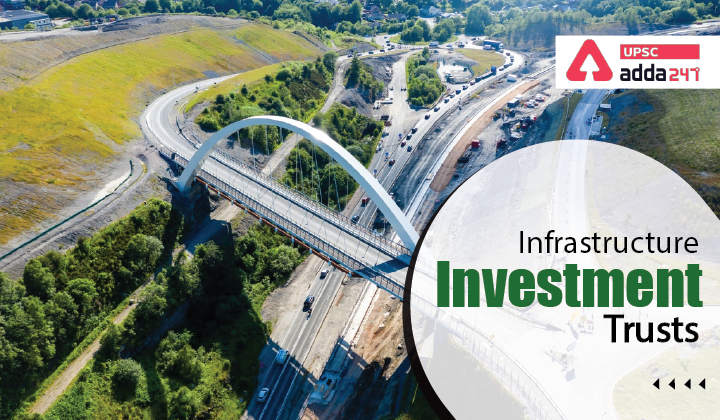Table of Contents
Infrastructure Investment Trusts UPSC: Relevance
- GS 3: Indian Economy and issues relating to planning, mobilization, of resources, growth, development and employment.
InvITs UPSC: Context
- Recently, SEBI has come out with a new norm to implement draft filing fees to be paid by Infrastructure Investment Trusts (InvITs) for initial offer and rights issue.
InvITs Infrastructure: Key points
- Now InvITs are required to pay non-refundable filing fees of 1 per cent in case of initial offer and 0.05 per cent in case of rights issue of the total issue size at the time of filing of draft placement with respect to private placement.
- Earlier, the InvIT was required to pay non-refundable filing fees of 0.1 per cent of the total issue size, irrespective of the type of issue.
What is InvIT? InvITs meaning
- InvITs are like mutual funds that pool money from investors. They are regulated by SEBI.
- InvITs could be set up for sectors defined under the infrastructure as per RBI guidelines.
- InvITs own and operate operational infrastructure assets like highways, roads, pipelines, warehouses, power plants,
- Typically, vehicles like InvITs are designed to pool money (small sums) from several investors to be invested in income-generating assets.
- They offer regular income (via dividends) and long-term capital appreciation.
InvITs: How do they operate?
- An InvIT is established as a trust settled by the sponsor under the Indian Trusts Act, 1882 and the trust deed registered in India under the Registration Act, 1908.
- Besides, a Certificate of Registration as an InvITs needs to be obtained from SEBI.
- Distributions by InvITs are based on Net distributable cash flows (NDCF), unlike companies where dividends are based on profits.
- At present, there are 15 InvITs registered with SEBI, and seven are listed on the stock exchanges.
Difference between InvITs and REITs
- Both InvITs and REITs (Real Estate Investment Trusts) are conceptually like mutual funds.
| Infrastructure Investment Trusts | Real Estate Investment Trusts |
| InvITs comprise a portfolio of infrastructure assets such as highways and power transmission assets. | REITs comprise a portfolio of commercial real estates |
| InvITs invest in infrastructure projects such as roads or highways, which take some time to generate steady cash flows | Real Estate Investment Trusts (REITs) are an investment vehicle that owns and manages investment grade and income-producing real estate properties such as offices, malls, industrial parks, warehouses, hospitality and healthcare centres. |
| InvITs can be publicy listed, private listed or private unlisted | REITs must be publicly listed. |
| InvITs’ cash flows are less certain as they are dependent on multiple factors, including the capacity utilisation of the underlying assets and scalability of tariffs. | REITs provide stable income and yield as 80 per cent of REIT assets are income-generating assets with long-term rental contracts. |
| InvITs comprise concessions where the projects are returned to the authority or rebid post the concession period. Here growth depends on the successful acquisition of concession assets through a bidding process. | REITs own the property leased out and their underlying assets see growth in value over time and have high terminal value. REITs have greater visibility of growth, which can be achieved by redeveloping existing assets, new construction, and acquiring completed leased assets. |
| InvITs have a bigger trading lot size and thus somewhat poor liquidity. | REITs are more accessible to small investors and have higher liquidity due to lower unit prices and trading lots. |
InvIT benefits
- InvITs present attractive investment opportunities and are expected to give a boost to the infrastructure projects, given the huge government outlay infrastructure creation.
- The government had already identified InvITs as a way to attract large institutional long-term investors in infrastructure space.
- For example: A large portion of fund could come through InvITs in the National Infrastructure Pipeline.
- InvIT helps developers release their invested equity and deploy capital in new projects.
- One of the benefits of InvITs for companies is that proceeds raised from such vehicles are not counted as debt.
Read UPSC favourite topics





 TSPSC Group 1 Question Paper 2024, Downl...
TSPSC Group 1 Question Paper 2024, Downl...
 TSPSC Group 1 Answer key 2024 Out, Downl...
TSPSC Group 1 Answer key 2024 Out, Downl...
 UPSC Prelims 2024 Question Paper, Downlo...
UPSC Prelims 2024 Question Paper, Downlo...





